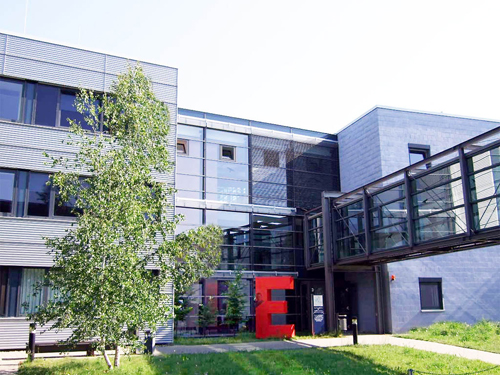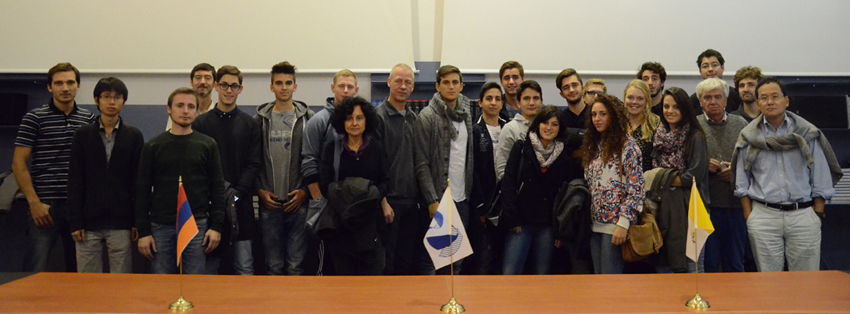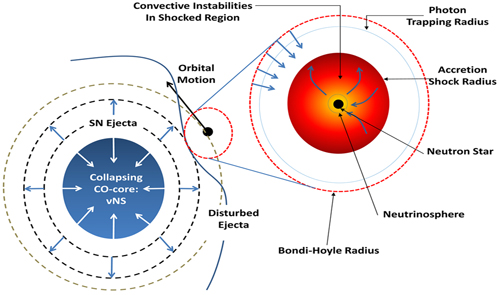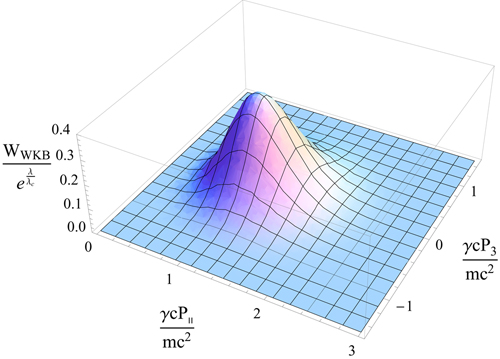

| Newsletter Russian July/October |

|

|





ICRANet Newsletter
Special Issue
July/October
1-ая научная конференция ICRANet в Ереване (Армения)
Черные дыры: сильнейшие источники энергии во Вселенной Главные научные результаты
Следом за церемонией открытия проф. Руффини представил доклад “Черные дыры, гамма-всплески и сверхновые. Лидирующий прогресс в физике и релятивистской астрофизике”, который включал в себя историю открытия гамма-всплесков, а также последние результаты их наблюдений и моделирования, напряду с прогрессом в понимании связи между сверхновыми и гамма-всплесками.
В секции «сильные поля» этой конференции в Армении, широко известные эксперты Кристоф Кайтель (Германия), Карен Хатсагортсян (Армения) и Антонино ди Пьяцца (Италия) из института Макса Планка (Гейдельберг, Германия) представили свои обзорные доклады об изучении ядерных взаимодействий при помощи интенсивных лазеров, фотонов высоких энергий при столкновении лазерных пучков, а также общий обзор явлений в сильных электромагнитных полях. Два обзорных доклада по астрофизике высоких энергий были представлениы Размиком Мирзояном (Германия-Армения) и Алессандро де Анджелисом (Италия). Мирзоян представил последние результаты наблюдений обсерваторией MAGIC галактических источников (в частности, остаток сверхновой W51 и Крабовидной туманности), внегалактических источников (IC 310, Mrk 412 и др.) и рассказал о текущем статусе телескопа CTA. Доклад по астрофизике гамма-лучей с энергией 10 Гэв, наблюдаемых при помощи черенковского излучения, был представлени де Анжделисом. Группа ICRANet (аспиранты программы EMJD, научные сотрудники ICRANet) представили результаты последних исследований гамма-всплесков, и также их связи со сверхновыми. Последние достижения в физике нейтронных звезд обсуждались Хорге Руэдой, Риккардо Бельведере и Куантаем Бошкаевым. Кроме того, Эккард Штробель, Янбин Ву, Хендрик Людвиг и другие представили результаты изучения сильных электромагнитных полей и приложения этих результатов в физике и астрофизике. Паоло Джомми и аспирант программы EMJD Бруно Сверсут представили выборку блазаров с высоким синхротронным пиком, интересных для наблюдений в ТэВ диапозоне энергий. Они пришли к выводу о том, что большинство из них будут обнаружены создающимся телескопом CTA, а некоторые из них, в моменты вспышек, даже современными черенковскими телескопами. Проф. Клаус Ламмерцаль из университета Бремена представил доклад «Движение пробной частицы в регулярных пространствах черных дыр».
Труды конференции Зельдович-100
Все материалы трудов конференции Зельдович-100, прошедшей в Минске в марте 2014 года собраны и отправлены в печать. Среди них: 18 статей с пленарной сессии и 32 статьи с параллельных сессий. Труды конференции будут изданы к концу 2014 года в специальных выпусках Астрономического журнала (статьи с пленарной сессии) и журнала Нелинейные явления в сложных системах (статьи с параллельных сессий). Оба журнала индексируются в системе Scopus, а Астрономический журнал индексируется также в Thomson Reuters. Редакторами этих выпусков журнала являются С.Я. Килин (Национальная академия наук Беларуси), Ремо Руффини (ICRANet) и Григорий Верещагин (ICRANet).
Публикация трудов 13 Итало-Корейской конференции по релятивистской астрофизике (15-19 июля 2013, Женский университет Ewha)
В этой конференции, проходящей раз в два года попеременно в Италии и в Кореее (см.: www.icranet.org/index.php?option=com_content&task=view&id=717), наряду с большим числом корейских профессоров, исследователей и студентов, приняло участние более 10 представителей ICRANet, которые также выступили с докладами. Труды конференции были недавно опубликованы в реферированном журнале “Journal of Korean Physical Society”. С обзором можно ознакомиться здесь: http://link.springer.com/journal/40042/65/6/page/1
Сотрудничество между ICRANet и инситутом А. Эйнштейна в Потсдаме
С июля ICRANet начал новую программу исследований “Точные решения в суперсимметричной общей теории относительности” в сотрудничестве с группой проф. Николаи в институте Альберта Эйнштейна в Потсдаме (Германия). Это новое направление исследований теперь дополняет список направлений в секторе “Точные решения уравнений Эйнштейна и Эйнштейна-Максвелла”.
Главная цель этих исследований – построение точных решений для супергравитационных солитонов.
Новые договоры, подписанные в Бразилии, Италии и Мексике
Дипломатическая активность проф. Руффини продолжается в южной Америке, где в июле и августе были подписаны новые важные договоры с некоторыми из крупных университетов Бразилии и Мексики.
В частности, были подписаны следующие договоры: 1 июля, в Нитерой (Бразилия), с UFF - Universidade Federal Fluminense; 9 июля в городе Мексико с UAM - Universidad Autónoma Metropolitana; 26 августа в Флорианаполисе (Бразилия) с UFSC - Universidade Federal de Santa Catarina; 29 августа, также в Бразилии, с UFPE - Universidade Federal de Pernambuco. 1 августа в Риме было подписано соглашение с CNR – Национальным советом по исследованиям, возглавляемым проф. Луиджи Николаисом.
Успех «Ночей исследователей» в ICRANet
Второй год подряд, центр ICRANet в Пескаре присоединяется к национальной программе "Ночь исследователей 2014" для ознакомления широкой публики с результатами исследовательской активности в Италии. Утром в пятницу, 26 сентября ученые ICRANet представили результаты своих исследований 150 ученикам старших классов школ Пескары. Кроме того, в ICRANet прошел день открытых дверей с программой экскурсий для публики, которая смогла увидеть своими глазами места, где ученые ICRANet углубляют наши знания о звездах и законах, управляющих Вселенной.
Наконец, в престижном здании Аурума Пескары, несколько ученых из нашего центра представили обширную программу лекций и наблюдений с телескопом: проф. Руффини сделал доклад "Сверхновые, гамма-всплески и черные дыры" доктор Константино Сиджизмонди сделал доклад "Сверхгигантские новые и переменные". Кроме того, вплоть до полуночи докторы Лука Иццо и Константино Сиджизмонди проводили наблюдения с телескопом как солнца, так и звезд.
Делегация датских студентов посетила центр ICRANet в Пескаре
23 октября делегация 6 датских студентов из Свендборга и сопровождающий их проф. Мадс Фьелдвиг Гаммельтофт, гости проф. Алессандры Пальмы из лицея "Леонардо да Винчи" в Пескаре посетили наш центр в Пескаре, где они прослушали, после приветствия директора ICRANet, проф. Руффини, лекцию "Свет и исследование Вселенной", прочитанную доктором Григорием Верещагиным, представителем факультета ICRANet.
Представлен постер 14 конференции Марселя Гроссмана, которая пройдет в Риме, Италия с 12 по 18 июля 2015 года
14 конференция Марселя Гроссмана пройдет в Риме, Италия, в университете «Сапиенца» с 12 по 18 июля 2015 года. Начиная с 1975 года, конференции Марселя Гроссмана были организованы, чтобы обеспечить возможность обсуждения последних достижений в понимании гравитации, общей теории относительности и релятивистских полевых теорий, делая упор на математические основы, физические предсказания и экспериментальную проверку. Целью этих конференций является стимулирование обмена между учеными, которые могут углубить наше понимание структуры пространства-времени, а также обобщить статус текущих экспериментов по проверке теории гравитации Эйнштейна как в наземных лабораториях, так и в космосе. Предыдущие конференции прошли в Триесте (1975 и 1979), Шанхае (1982), Риме (1985), Перте (1988), Киото (1991), Стэнфорде (1994), Иерусалиме (1997), Риме (2000), Рио де Жанейро (2003), Берлине (2006), Париже (2009) и Стокгольме (2012). Заинтересованные в участии могут обратиться к одному из членов оргкомитета, либо в секретариат.
Конференция Марселя Гроссмана в 2015 году посвещается 100-летию уравнений Эйнштейна, международному году света 2015, организованному ЮНЕСКО, а также золотому юбилею релятивистской астрофизики; все эти события будут отмечаться на MG14, и на других корфенерциях-спутниках в Армении, Бразилии, Израиле, Индии, Китае, Мексике, США и Южной Корее. Постер конференции можно скачать здесь: http://www.icra.it/mg/mg14/MG14_poster.pdf В данный момент планируется научная программа, с обновлением некоторых предыдущих параллельных секций, и с добавлением новых. Вебсайт конференции: http://www.icra.it/MG/mg14/ Электронная почта: mg14@icra.it
ICRANet Faculty and Student’s Scientific Research articles
GRB 130427A and SN 2013cq: A Multi-wavelength Analysis of An Induced Gravitational Collapse Event
R. Ruffini, Y. Wang, M. Kovacevic, C.L. Bianco, M. Enderli, M. Muccino, A.V. Penacchioni, G.B. Pisani, J.A. Rueda
Accepted by ApJ In the particle physics, the interaction between particles generates new particles, named as S-matrix. For instance, a pair of quark and anti-quark produces W/Z boson and Higgs boson, the outcome of electron and positron interaction could be a pair of muon and anti-muon, the duration of such interaction is fleeting, the above two reactions only take 10−26 s and 10−23 s respectively. In the marco-scale astrophysics, some phenomena are apparently similar to the micro-scale particle physics, a famous example is the similarity of electron and blackhole, both can be completely characterized by only mass, electric charge, and angular momentum. Here in our new accepted Astrophysical Journal paper, we introduce a new celestial matrix, C-matrix, an analogue to the S-matrix (Fig.1). C-matrix depicts a binary system composed of one neutron star and one massive star as the initial state, and the products after about 100s interaction are one new neutron star and one black hole. The story of this process can be outlined as: The massive star undergoes a supernova and eject its massive shell, the companion neutron star accretes the ejecta until reaching its critical mass and collapses into a black hole, simultaneously an over critical electrical field is generated around the black hole and electro-positron plasma are produced from it, this plasma flow expands ultra-relativisticly and collides with the inter-stellar medium, which gives origin to the gamma-ray burst (GRB), GRB is considered as an energetic explosion which emits huge abundant photons, mainly the gamma-rays. On April 27, 2013, such aforementioned event occurred and triggered Fermi satellite, later various satellites and telescopes joined the observation. This event was named as GRB 130427A, it is one of the few GRBs which has hundreds of seconds simultaneous data in the optical, X-ray and GeV emission, especially precious is its GeV emission, due to the long duration, high intensity and containing the highest energy photon (95.3 GeV) ever observed in GRBs. We proceeded to make a multi-wavelength analysis. The high energy GeV emission appears to be detectable at the end of the prompt radiation phase(∼ 20s), when the fluence of X-ray and γ-ray of the prompt exponentially decrease and becomes transparent for GeV photons. After 200s, the Lorentz factors of X-ray and GeV are very different, and their physical origin are necessarily different. The high energy can originate from the interaction of some of the physical components (e.g., neutron star and black hole) newly created in the C-matrix. ![fig1 [fig1]](newsletters/luglio2014/fig1_small.jpg)
Figure 1: Three different matrices in fundamental physics. The first is the quark matrix leading to a Higgs boson. In the middle is the classical electron-positron pair matrix, generating an muon and anti-muon pair. The third matrix is the celestial one, which is considered in the present work. ∆t is the duration of intermediate state. The interaction of the GRBs with the SN ejecta may well generate the X-ray emission and the associated thermal component. By analyzing the X-ray data from 195s to 461s, a crucial evidence was found, that adding a blackbody component could efficiently improve the fitting (Fig. 3), the obtained blackbody temperature is in the range of 0.3 KeV to 0.5 KeV, the radiation radius is deduced from about 7 × 1012 cm to 2.8 × 1013 cm, with the expansion speed at 0.8c, c is the speed of light. These above value is typical for the supernova ejecta accelerated by the collision with GRB outflow. GCN 14526: The late X-ray observations of GRB 130427A by Swift-XRT clearly evidence a pattern typical of a family of GRBs associated to supernova (SN) following the Induce Gravitational Collapse (IGC) paradigm (Rueda & Ruffini 2012; Pisani et al. 2013). We assume that the luminosity of the possible SN associated to GRB 130427A would be the one of 1998bw, as found in the IGC sample described in Pisani et al. 2013. Assuming the intergalactic absorption in the I-band (which corresponds to the R-band rest-frame) and the intrinsic one, assuming a Milky Way type for the host galaxy, we obtain a magnitude expected for the peak of the SN of I = 22 - 23 occurring 13-15 days after the GRB trigger, namely between the 10th and the 12th of May 2013. Further optical and radio observations are encouraged. After the first days observation, we found that the X-ray afterglow of GRB 130427A overlaps other GRBs induced by C-matrix (Fig.4), we concluded that this new GRB shared the same mechanism, which means a supernova is inevitable in the system though the optical signal is too weak too be observed, immediately we sent a letter to GCN on May 2, 2013, predicting that the optical R-band of a SN will reach its peak magnitude in about 10 days in the cosmological rest-frame on the basis of the IGC paradigm, and we encouraged observations. ![fig2 [fig2]](newsletters/luglio2014/fig2_small.jpg)
Figure 2: Flux of first 700 s. Blue points are the Fermi-LAT high energy emission from 100 MeV till 100 GeV, grey dotted line represents the Fermi-GBM, from 10 keV to 900 keV, green dashed line represents the photons detected by Swift BAT from 10 keV to 50 keV, and red solid line is the soft X-ray Swift-XRT detection, in the range of 0.3 KeV to 10 KeV. From this figure, clearly the Fermi-LAT emission reaches highest fluence at about 20 s while the gamma-ray detected by Fermi-GBM releases most of the energy within the first 10 s. ![fig3 [fig3]](newsletters/luglio2014/fig3_small.jpg)
Figure 3: Spectral fitting of three time intervals (196s - 246s, 246s - 326s, 326s - 461s) in Episode 3, data come from Swift-XRT (0.3 KeV - 10 KeV, without pile-up area). Black points are the deduced data, green dashed line presents the thermal component, blue long-dashed line is the power law component, and red line shows the combination of these two components. Clearly the flux of thermal component drops and the temperature decreases along the time. ![fig4 [fig4]](newsletters/luglio2014/fig4_small.jpg)
Figure 4: Overlapping of GRB 130427A and GRB 060729. Green cross is the light curve of GRB 060729. Red triangle and orange dots represent the light curve of GRB 130427A respectively before and after May 2, 2013. The vertical line marks the time of 2 × 104 s which is the lower limit for the domain of validity of the Pisani relation prior to GRB 130427A.
Letter in collaboration with Pror. Fryer, Los Alamos:
Hypercritical Accretion, Induced Gravitational Collapse, And Binary-Driven Hypernovae
Chris L. Fryer, Jorge A. Rueda, Remo Ruffini
ApJ Letters 793, 36 (2014) The induced gravitational collapse (IGC) paradigm has been successfully applied to the explanation of the concomitance of gamma-ray bursts (GRBs) with supernovae (SNe) Ic. The progenitor is a tight binary system composed by a carbon-oxygen (CO) core and a neutron star (NS) companion. The explosion of the SN leads to hypercritical accretion onto the NS companion which reaches the critical mass, hence inducing its gravitational collapse to a black hole (BH) with consequent emission of the GRB. The first estimates of this process were based on a simplified model of the binary parameters and the Bondi-Hoyle-Lyttleton accretion rate. We present here the first full numerical simulations of the IGC phenomenon. We simulate the core-collapse and SN explosion of CO stars to obtain the density and ejection velocity of the SN ejecta. We follow the hydrodynamic evolution of the accreting material falling into the Bondi-Hoyle surface of the NS all the way up to its incorporation to the NS surface. The simulations go up to BH formation when the NS reaches the critical mass. For appropriate binary parameters the IGC occurs in short timescales (100-1000s) owing to the combined effective action of the photon trapping and the neutrino cooling near the NS surface. We also show that the IGC scenario leads to a natural explanation for why GRBs are associated only to SN Ic with totally absent or very little helium.
Semiclassical pair production rate for time-dependent electrical fields with more than one component: WKB-approach and world-line instantons
Strobel, Eckhard; Xue, She-Sheng
Nuclear Physics B 886, 1153 (2014) Description: The Schwinger-effect describes how pairs of electrons and positrons can be produced from the vacuum with the help of a very strong electric field. While this effect is believed to play a important rule in astrophysics, especially for gamma ray burst, it has never been observed directly in a laboratory. The reason for this is that currently one can not produces the field strengths which are necessary to produce a measurable number of pairs. This might change with the construction of new high energy laser systems, like the Extreme Light Infrastructure (ELI). It has recently been shown that pair creation rate changes over several orders of magnitude depending on the form of the laser pulse. To design an experiment in which Schwinger pair creation can be measured directly it is substantial to understand this dependence. While a lot of computations can be performed numerical it is worthwhile to continue to study approximate analytical methods to strengthen this understanding. In the paper we generalize two well-known analytical methods, namely the WKB and the world line instant on method, to fields which have more than one time-dependent component. The comparison of the two methods shows when to best use which of the methods. The generalizations enables us to find a analytic solution for the momentum spectrum of the produced pairs in a rotating electric field. As displayed in Figure no pairs are produced which have zero momentum. This is a big difference to the known cases of one-component fields, where most pairs are produced with zero momentum. Since the rotating electric field is a approximation for the field in the anti-node of a circularly polarized standing wave, which can be produced in laser experiments, the characteristic shape of this momentum spectrum might help to distinguish the pairs produced by the Schwinger process from those produced due to other strong field effects.
Submitted Articles:
Induced Gravitational Collapse At Extreme Cosmological Distances: The Case Of Grb 090423
R. Ruffini, L. Izzo, M. Muccino, G.B. Pisani, J.A. Rueda, Y. Wang, C. Barbarino, C.L. Bianco, M. Enderli, M. Kovacevic A&A 569, A39 (2014)
The Genuine Short Grb 090227b And The Disguised By Excess Grb 090510
M. Muccino, C.L. Bianco, L. Izzo, Y. Wang, M. Enderli, M. Kovacevic, G.B. Pisani, A.V. Penacchioni, R. Ruffini Gravitation and Cosmology, 20, 197 (2014)
On The Core-Halo Distribution Of Dark Matter In Galaxies
Remo Ruffini, Carlos Argüelles, Jorge A. Rueda Submitted to Phys. Rev. Lett.
Just Published Articles:
Semiclassical Pair Production Rate For Time-Dependent Electrical Fields With More Than One Component: Wkb-Approach And World-Line Instantons
Strobel, Eckhard; Xue, She-Sheng Nuclear Physics B 886, 1153 (2014)
Transparency Parameters From Relativistically Expanding Outflows
Bégué, D.; Iyyani, S. ApJ 792, 42 (2014)
Dynamical Instability Of White Dwarfs And Breaking Of Spherical Symmetry Under The Presence Of Extreme Magnetic Fields
J. G. Coelho, R. M. Marinho, M. Malheiro, R. Negreiros, D. L. Cáceres, J. A. Rueda, R. Ruffini ApJ 794, 86 (2014)
Are The Most Super-Massive Dark Compact Objects Harbored At The Center Of Dark Matter Halos?
Carlos R. Argüelles, Remo Ruffini Essay selected for Honorable mention 2014 by the Gravity Research Foundation
Strangeness Content Of Neutron Stars With Strong Sigma-Hyperon Repulsion
M. Razeira, A. Mesquita, C. A. Z. Vasconcellos, R. Ruffini, J. A. Rueda, R. O. Gomes Astronomische Nachrichten 335, 739 (2014)
Effective Field Theory For Neutron Stars With Strong Sigma--Hyperon Repulsion
M. Razeira, A. Mesquita, C. A. Z. Vasconcellos, R. Ruffini, J. A. Rueda, R. O. Gomes Astronomische Nachrichten 335, 733 (2014)
A search for Fermi bursts associated with supernovae and their frequency of occurrence
Kovacevic, M.; Izzo, L.; Wang, Y.; Muccino, M.; Della Valle, M.; Amati, L.; Barbarino, C.; Enderli, M.; Pisani, G. B.; Li, L. Astronomy & Astrophysics, Volume 569, id.A108, 6 pp. (A&A Homepage) |
|||||||
|
||











